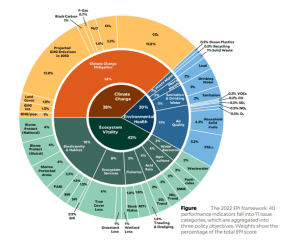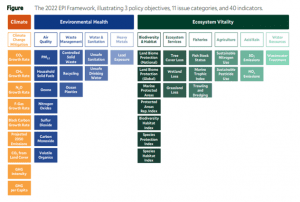THE CONTEXT: The Environmental Performance Index, 2022 (EPI 2022)released on World Environment Day (June 5) is in news due to India’s dismal rank. The Index has ranked India at the bottom position among 180 countries. However, some environmental experts have noted some flaws in the methodology of the Index. Even the Ministry of Environment has issued a rebuttal saying the indicators used in the assessment are based on ‘unfounded assumptions’. This article discusses the report in detail and why India has issued a counterargument to the report.
ENVIRONMENT PERFORMANCE INDEX
Ø The EPI is an international ranking system of countries based on their environmental health. It is a Biennial Index, first started in 2002 as the Environment Sustainability Index by the World Economic Forum.
Ø It is prepared by the Yale Centre for Environmental Law and Policy in collaboration with the Columbia University Centre for International Earth Science Information Network.
Ø EPI 2022 uses 40 performance indicators to assess and rank 180 countries. The indicators “measure how close countries are in meeting internationally established sustainability targets for specific environmental issues”.
Ø The 40 indicators are under the broad categories of climate change performance, environmental health, and ecosystem vitality. The 2022 EPI has included new parameters to its earlier assessments, with projections of progress towards net-zero emissions in 2050, as well as new air quality indicators, and sustainable pesticide use.

KEY FINDINGS OF ENVIRONMENTAL PERFORMANCE INDEX, 2022
Ø India has been ranked 180(last out of 180 countries) with a score of 18.9. India’s rank was 168 (score 27.6) in 2020. India has been ranked lower than Pakistan, Bangladesh, Vietnam and Myanmar, the poorest performers. Denmark tops the list with a score of 77.9.The United Kingdom and Finland secured 2nd and 3rd positions.
Ø India ranks close to the bottom on a number of indicators including:
- Ecosystem Vitality (178th),
- Biodiversity (179th),
- Biodiversity Habitat Index (170th),
- Species Protection Index (175th).
Ø Apart from this, there is a dismal performance with respect to wetland loss,
- Air Quality (179th),
- PM 2.5 (174th),
- Heavy Metals such as Lead in water (174th),
- Waste Management (151st) etc.
Ø The report suggests that China, India, the U.S., and Russia will account for over 50 per cent of residual global greenhouse gas emissions in 2050. (Greenhouse gasses (GHG) include carbon dioxide, methane, fluorinated gasses, and nitrous oxide.)
REASONS ATTRIBUTED TO INDIA’S POOR RANK
AIR POLLUTION
- India is home to 21 of the 30 most polluted cities in the world and has air quality rated one of the poorest in the world. Over 16 lakh people in India die from air pollution every year, according to the report.
- It also identifies household fuel combustion as the largest contributor to the country’s particulate matter emissions.
- Seven indicators are used to determine the air quality in the listed countries. These include PM 2.5 exposure, household solid fuels, ozone exposure, nitrogen oxides exposure, sulphur dioxide exposure, carbon monoxide exposure, and volatile organic compound exposure.
PLASTIC WASTE GENERATION
- India and Indonesia have been identified as the top two generators of marine plastic waste in the world, while China has managed to decrease its ocean plastic pollution. Ocean plastic pollution is measured as an absolute quantity of the amount of plastic released by a country into the ocean annually. Indonesia, India, the U.S, Brazil and Thailand are the top five producers of ocean plastic pollution and are responsible for 43% of the global total.
PROTECTION OF BIOMES
- In an analysis of countries protecting the world’s biomes, India emerged at the bottom in five out of 14 sub-categories – the most for a single nation.
The Environmental Performance Index report noted that most countries that scored low have prioritized economic growth over sustainability.

OBJECTIONS HAVE BEEN RAISED BY INDIA:
- As per the Environment Ministry, some of the indicators used for assessing performance are extrapolated and based on unscientific methods.
- Shifting of weightage on many indicators has resulted in India’s low ranking. For example, for black carbon growth, India’s score actually improved from 32 in 2020 to 100 (the top score) in 2022. However, the weightage of this indicator has been reduced to 0.0038 in 2022 from 0.018 in 2020. Climate Change has been given very high weightage (38% or 0.38) and tends to neglect the development needs of poorer countries.
- Similarly, the low weightage given to per-capita GHG emissions automatically reduces the ranks of countries like India and China. The projection for GHG emissions has been computed based on the average rate of change in emissions over the last 10 years. It is not based on modelling that takes into account a longer period, the extent of renewable energy capacity and use, additional carbon sinks etc. Crucial carbon sinks that mitigate GHG, such as forests and wetlands, have not been taken into account by the report.
- Further, India’s low emissions trajectory, unlike the high historical trajectories of developed countries, has been ignored. The US and the EU should have the highest-burden considering their historic emissions.
- The EPI assumes every country is in the same position economically, developmentally and environmentally, therefore all had to achieve net zero emissions by 2050.
- Other Objections:
- The index emphasizes the extent of protected areas rather than the quality of protection that they afford. The computation of biodiversity indices does not factor in the management effectiveness evaluation of protected areas.
- Indicators such as agrobiodiversity, soil health, food loss and waste are not included even though they are important for developing countries with large agrarian populations.
THE ANALYSIS OF THE ISSUE:
- The report has found that “good policy results are associated with wealth (GDP per capita)’’, meaning economic prosperity makes it possible for nations to invest in policies and programmes that lead to desirable outcomes. This trend is especially true for issue categories under the umbrella of environmental health, as building the necessary infrastructure to provide clean drinking water and sanitation, reduce ambient air pollution, control hazardous waste, and respond to public health crises yields large returns for human well-being, however in pursuit of economic prosperity (manifested in industrialisation and urbanization) often means more pollution and other strains on ecosystem vitality, especially in the developing world and hence poorer rank.
- According to environmental scientists in India, the weights are the agency’s discretion; but giving climate change such a high weightage is problematic. The EPI 2022 makes an assumption that every country has to reach net zero by 2050 — whereas the understanding is that developing countries will need more time. India has also committed to Net-Zero Emissions by 2070. Noone can be expected to forgo energy for development. The EPI 2022 is neither ethically correct nor reflects the political reality.
- In developing countries, of which many like India have low emissions trajectories, the contribution is not that emissions reduce but to avoid locking into higher emissions trajectories. That is what is expected of developing countries, but the methodology used doesn’t allow for that and the government is correct in pointing this out.
THE WAY FORWARD:
- The parameters of the report should be modified in order to enhance its credibility. The accurate method would be to calculate GHG emissions per capita. Further, a model should be created with coefficients taking into account the effect of policies to reduce emissions. This will help in the better projection of the values for future years. Such policies include increased use of renewable energy and electric vehicles or the creation of a carbon sink.
- Climate change is a global environmental problem, and because its effects depend on the accumulation of greenhouse gases over time, measuring progress in a given country is challenging. Unlike air quality, where absolute increases or decreases in emissions of air pollutants in that country signal progress, climate change mitigation has to be measured against what it is reasonable and fair to expect from different countries, taking into account their past emissions as well as national contexts.
- India must make sure that its current environmental policies and commitments are duly honoured. For instance, India has announced a ban on single-use plastic, in effect from 1st July 2022. The policy should be properly implemented and also the masses be made aware of the contributions that they can make.
- India must strengthen its environmental litigation framework by establishing more benches of National Green Tribunals across the country. This will promote environmental consciousness and encourage people to file complaints against the violators.
- The present approach is bound to make richer countries look good, because they have accumulated emissions in the past, but these have started declining in the last decade. Meanwhile, poorer countries that have emitted comparatively little in the past, look bad even as they are grappling with addressing poverty while trying to limit emissions.Through choices of biased and skewed benchmarks, also hurts honest global conversation and much-needed progress on the global climate crisis that it purports to foreground it should not stifle honest conversation. The needed changes in the methodology shall be made.
- Whatever may be the findings of the report and the rebuff by the government, India’s local environmental performance on air, water and forests is deeply problematic.Air quality in India is now the second largest risk factor for public health in India, behind only child and maternal nutrition. Rivers and lakes are increasingly polluted, rivers are drying, groundwater tables are rapidly declining, and gains in tree cover hide declining natural productivity and diversity of forests and grasslands. Solid waste mounts and pesticide contamination is unabated. It is time that we look within and have more stringent implementation and execution of the programmes and policies.
THE CONCLUSION: Indexes are inherently problematic, especially when applied to something as multi-dimensional and complex as environmental performance. In trying to quantify, aggregate and rank, index makers have to make judgements about what issues count, how they are best measured individually, and how much importance to give to each issue and indicator in aggregating. Moreover, when ranking countries, one is essentially applying the same standard across vastly different socio-ecological contexts – this involves difficult choices and demands changes in the approach. Despite the inconsistencies in the Environmental Performance Index 2022, the Government should not ignore the fact that India experiences severe environmental issues (especially air pollution) that need to be addressed urgently for attaining sustainable development.
Mains Practice Question:
- Indexes are inherently problematic, especially when applied to something as multi-dimensional and complex as environmental performance. Analyze in context of Environment Performance Index, 2022.
- The Government of India has questioned the parameters of the recently released Environmental Performance Index 2022. What are the parameters questioned and suggest ways to maintain the principle of equity among the nations to address the environmental challenges?

